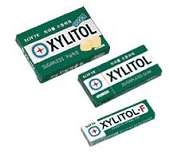Military Fights Cavities with Xylitol Gum in MREs
 In February 2007 I wrote two articles about how to prevent and cure dental cavities. One of the things I uncovered was Xylitol, a natural sugar, kills the bacteria that causes cavities. When I was in Thailand I saw that all the chewing gum there was sweetened with Xylitol. But in the Americas gum was either sweetened with sugar or toxic artificial sweeteners. It looks like finally the USA has caught up with Asia. The US Military will be putting gum sweetened with Xylitol in the Meals Ready to Eat (MRE) that soldiers eat when in the field. http://www.armymedicine.army.mil/hc/healthtips/13/200403mre.cfm
In February 2007 I wrote two articles about how to prevent and cure dental cavities. One of the things I uncovered was Xylitol, a natural sugar, kills the bacteria that causes cavities. When I was in Thailand I saw that all the chewing gum there was sweetened with Xylitol. But in the Americas gum was either sweetened with sugar or toxic artificial sweeteners. It looks like finally the USA has caught up with Asia. The US Military will be putting gum sweetened with Xylitol in the Meals Ready to Eat (MRE) that soldiers eat when in the field. http://www.armymedicine.army.mil/hc/healthtips/13/200403mre.cfm
“Don’t wait to start using xylitol gum,” said dela Cruz. “The gum can be purchased on the local economy and at commissaries, although the choice of flavors may be limited at smaller commissaries. Read the ingredients on the label and make sure that xylitol is the first ingredient. Chewing the gum at least five minutes is extremely important for maximum effectiveness.”
From the US Military Fact Oral Health Sheet – Fight Tooth Decay With Xylitol
You brush and floss your teeth daily, visit the dentist every year for an exam and a cleaning, avoid sugary foods and treats, and drink fluoridated water. Do you also have to give up chewing gum or mints?
No! In fact, some gum or mints can actually give you more protection if they contain a sugar called xylitol (zy-li-tol). It is a natural sweetener found in fruits and vegetables such as yellow plums, strawberries, and raspberries. It is usually made from certain hardwoods such as the birch tree.
How does xylitol work?
- Blocks bacteria from producing the acids that cause tooth decay.
- Decreases the level of cavity-causing bacteria.
- Decreases plaque formation.
- Enhances remineralization (hardening) of weakened teeth.
Because it fights bacteria so well, people who chew xylitol gum can reduce their risk of cavities. This is especially important for deployed Soldiers who may be at higher risk of tooth decay if they are not able to brush regularly and eat meals with high
amounts of carbohydrates (starch), such as Meals-Ready-to-Eat (MREs).
Other reasons to chew xylitol gum
- It is safe for the whole family.
- Has 40% less calories than sugar.
- Makes your mouth feel fresh and cool.
- Tastes as sweet as sugar with no aftertaste.
- You can buy it at the candy counter.
- It is a natural sweetener.
- It relieves “dry mouth” by increasing saliva.
- It can reduce ear infections.
How can I get the most benefit from xylitol?
- Chew 1.5 – 2 grams of xylitol gum for 5 minutes, 3 to 5 times a day.
- Chew xylitol gum after meals or as a snack.
- Xylitol-sweetened mints can be used by people who can’t or prefer not to chew gum.
How do I find gum or mints that contain xylitol?
Read the label. Xylitol should be the first ingredient listed on the label before other sweeteners. If you can’t find xylitol gum or mints at your PX or Commissary, ask the manager to order them.
Predict All Future Innovations
I’ve developed a method that allows you to predict all innovations for any product, service or entire industry.
Innovation is an information processing activity. To innovate you gather, analyze, organize, and then put information to use. Innovation is more than just thoughts and dreams. To make innovation real you must do something. To successfully innovate you must implement the right ideas at the right time in the right way. The Predictive Innovation Method helps you at each step of the way.
How does the Predictive Innovation Method work?
The method is based on a few basic premises, one is all possible concepts can be described, even if current technology can’t deliver them yet. Think of it like a library. There is a section and a shelf for everything. Sometimes the book has already been written and its there on the shelf when you want it. Other times you look and the book is missing. That is an innovation waiting to happen.
Another basic premise is there are consistent physical laws that govern the universe. Everything in the universe works within these laws. The interactions produce the tremendous variety we find. We see this all around us. Everything is made up of basic components following the same laws to create the variety we experience.
For example consider the common expression “the world is not black and white, it is shades of gray.” The intent is to say the world is complex and there are more than two choices. This implies decisions might be difficult or impossible.
When you examine it more closely you find something amazing. Starting with any two shades of gray you can never achieve the entire range. You can’t get darker or lighter than the two starting points. You are stuck moving to a dull point in the middle.
On the other hand if you start with black and white you can mix those two and achieve all shades of gray plus the extremes of black and white. The correct system produces infinite results with precision.
During my 25 years of experience analyzing literally thousands of systems the same basic elements and structures kept popping up. I discovered that by breaking down anything into 3 specific dimensions creating approximately 7 sets of 15 by 7 matrices I can describe anything with enough accuracy to be able to build it.
Anyone can quickly learn this method and start producing all the innovations they need. It makes innovation measurable and manageable.
My goal is to work with an organization that will support me promoting this method.
Contact me
Where to Start? Always Start With Customers!
I recently taught a short introduction to Predictive Innovation class for a group of design students at Eastern Michigan University (EMU). One of the students listed his biggest problem as, “not knowing where to start.” He had a product idea and hundreds of ways to approach it but he didn’t know how to begin to get it to market.
I must apologize to that student because I did not clearly answer his question. The correct answer of where to start is always, “Start With Customers!”
Outcome diagram the customers’ desires. Find the most pressing must be satisfied outcome then base your product and marketing around that desire. Make sure there are enough customers you can reach and who will pay for the product or service you plan to offer. If you can, pre-sell your product to them. Use their up front commitment to get financing to develop the product. That might mean actually having them pay or it might mean showing the width and depth of demand to investors.
Figure out what products the customers already own or use and try to use those as resources to develop your product. If they already own items that perform 80% of the tasks then its much easier for you to be an add-on rather than reinventing the wheel. For instance if they have a laptop with a USB connector then you can get power for your device from their laptop battery. Or you can use the keyboard and screen of their laptop to see and change settings in your small USB device.
Figure out all the desires that your product or future or generations of your product could satisfy. Look at the lifetime value of the customer relationship.
If you’re planning to partner with another company to get your product to market they are your customers as much as the end consumer. Draw the outcome diagram for all the desires related to buying and selling your product. Make sure you satisfy those outcomes.
The particulars of manufacturing or a design alternative over another are just details. The most important thing to remember, “Start With Customers.”



 Predictive Innovation Training
Predictive Innovation Training Predictive Innovation: Core Skills Book
Predictive Innovation: Core Skills Book RoundSquareTriangle.com
RoundSquareTriangle.com